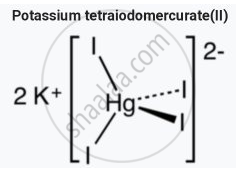Advertisements
Advertisements
प्रश्न
What is Nessler’s reagent ?
उत्तर
- Nessler's reagent is a solution of mercury(II) iodide (HgI2) in potassium iodide (KI) and potassium hydroxide (KOH) named after the German chemist Julius Nessler
- Nessler’s reagent is an alkaline solution of K2 HgI4

- It is used in testing for ammonia, with which it forms a brown coloration or precipitate.
APPEARS IN
संबंधित प्रश्न
Describe the laboratory method of preparation of ammonia
What is the action of Excess of air on ammonia ?
What is the action of the following reagents on ammonia :
Nessler's reagent
Mention the conditions required to maximise the yield of ammonia.
How does ammonia react with a solution of Cu2+?
How is ammonia manufactured industrially?
What happens when (NH4)2Cr2O7 is heated? Write the equations.
What is the action of Na Metal on ammonia?
In laboratory ammonia is prepared by heating:
Which compound is used as the cooling liquid in refrigerators?
In Haber’s process for the manufacture of NH3:
Ammonia on reaction with hypochlorite anion can form:
The shape of ammonia molecule is ____________.
When ammonia is heated with cupric oxide, a molecule of ammonia will ____________.
Liquid ammonia bottles are opened after cooling them in ice for some time. It is because liquid NH3 ____________.
Ammonia is generally manufactured for fertilizers by the reaction:
Which one of the following is not a use of ammonia?
A brown ring is formed in the ring test for \[\ce{NO3^{-}}\] ion. It is due to the formation of ______.
\[\ce{PCl5}\] reacts with finely divided silver on heating and a white silver salt is obtained, which dissolves on adding excess aqueous \[\ce{NH3}\] solution. Write the reactions involved to explain what happens.
